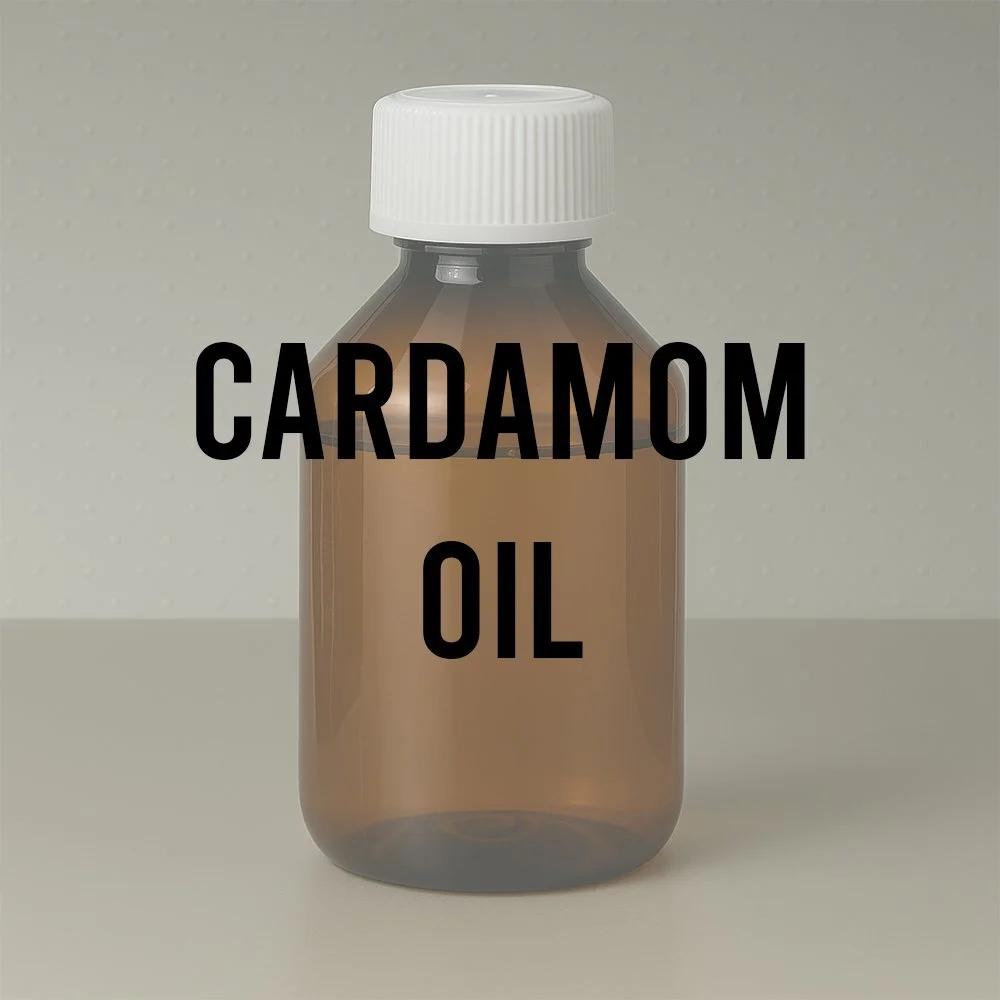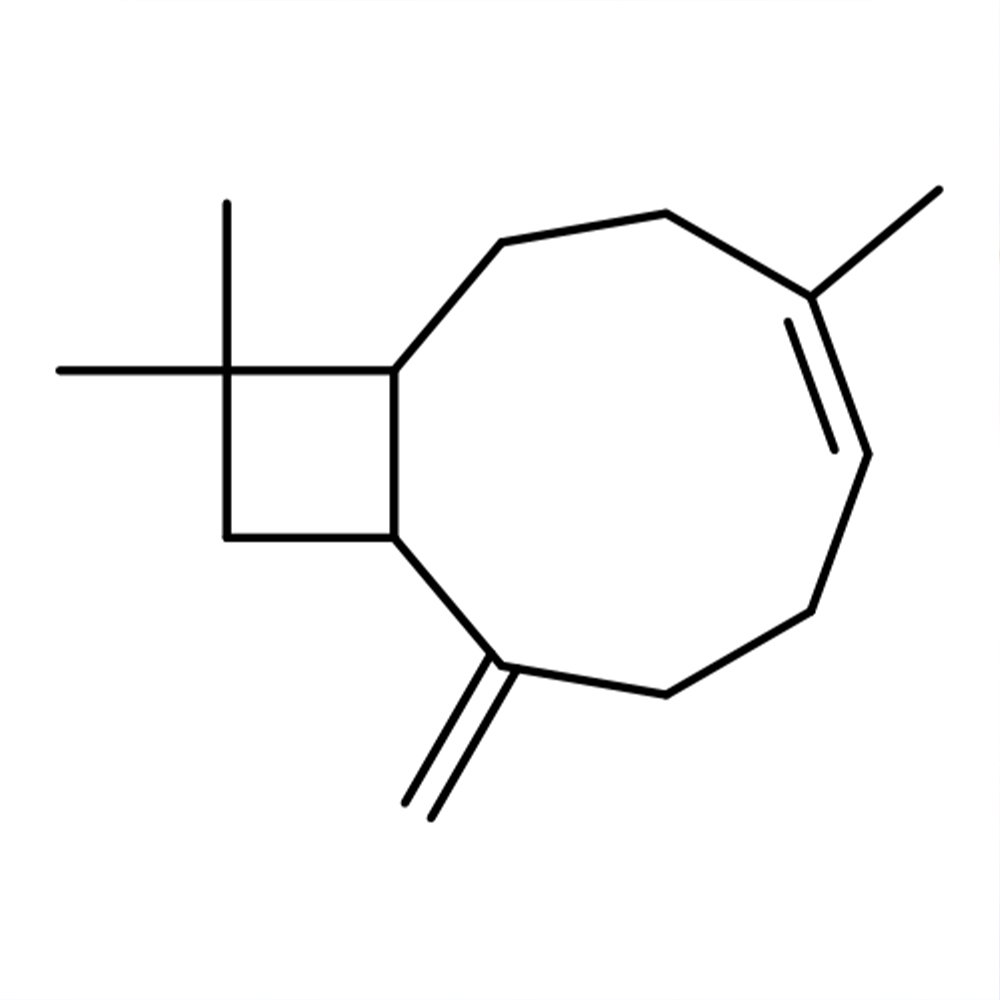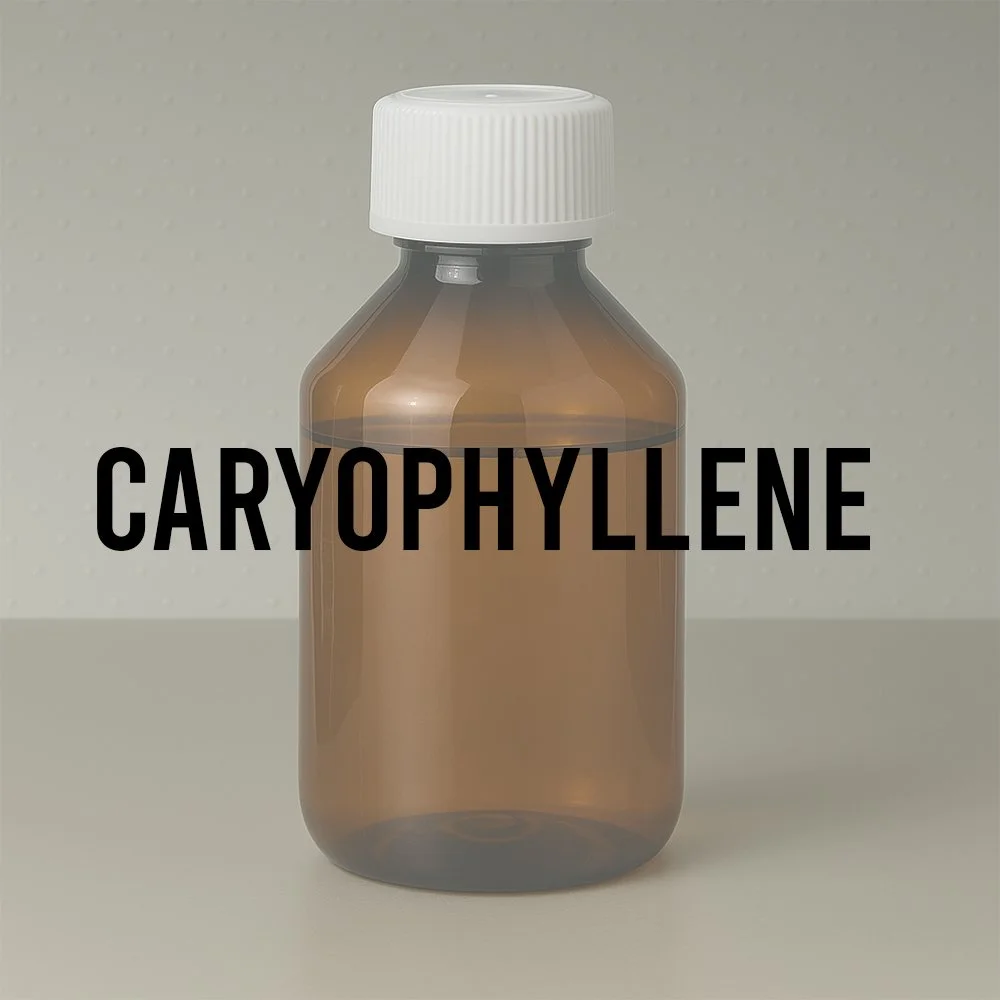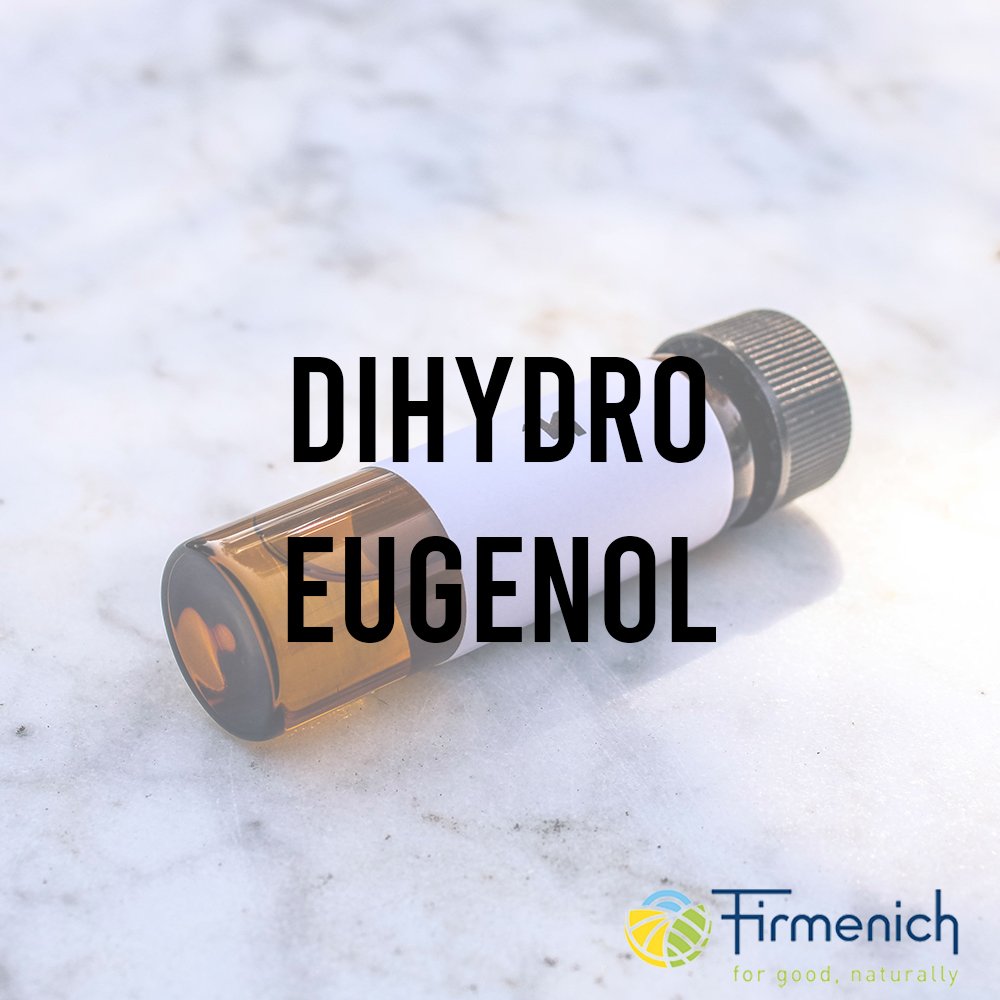Natural Ingredient Overvirew
Technical Ingredient Overview
🔎 Chemical Name — Essential oil of Elettaria cardamomum
🧪 Synonyms — Cardamom essential oil, Elettaria cardamomum seed oil, green cardamom oil
📂 CAS Number — 8000-66-6
📘 FEMA Number — 2241
⚖️ Molecular Weight — Not applicable (natural complex mixture)
📝 Odor Type — Spicy-aromatic
📈 Odor Strength — Medium to strong (6-7/10)
👃🏼 Odor Profile — Warm-spicy, aromatic, initially camphoraceous and eucalyptus-like; transitions to sweet balsamic, woody, and floral with persistent warmth
⚗️ Uses — Floral accords (muguet, rose), oriental compositions, chypre bases, powdery fragrances, citrus-spice colognes, fine fragrances, flavor applications
🧴 Appearance — Colorless to pale yellow or light brown liquid; darkens with light exposure
What is Cardamom Oil?
Cardamom oil is a natural essential oil obtained via steam distillation of the dried seeds of Elettaria cardamomum (L.) Maton, commonly known as green cardamom or true cardamom. Belonging to the ginger family (Zingiberaceae), it represents one of the oldest and most valued aromatic extracts in both perfumery and flavor chemistry (Arctander, 1960).
The oil is a complex natural mixture comprised predominantly of oxygenated monoterpenes (40.7–66.7%) and monoterpene hydrocarbons (23.1–58.6%), with trace sesquiterpenes (0.1–2.0%). Major constituents include 1,8-cineole (23–35%), α-terpinyl acetate (32–45%), α-terpineol (0.8–13.2%), β-linalool (0.4–11.0%), and sabinene (1.9–4.9%) (Ashokkumar et al., 2021). These components contribute synergistically to the oil's distinctive warm-spicy character with camphoraceous-eucalyptic top notes and sweet balsamic-woody undertones.
Oil quality varies significantly with geographic origin, botanical variety (E. cardamomum var. major vs. minor), harvest timing, and distillation technique. Guatemalan and Southern Indian oils (particularly Malabar and Mysore types) are most valued for perfumery applications, with typical yields ranging from 4.5–9.6% from dried seed material (Ashokkumar et al., 2021).
Historical Background
Cardamom ranks among the world's most ancient aromatic materials, with documented use spanning over 4,000 years. The Ebers Papyrus, dating to approximately 1500 BCE, chronicles ancient Egyptian applications in medicines, embalming, and ritualistic practices. Egyptians chewed cardamom pods for dental hygiene and breath freshening, while Romans employed the spice medicinally for digestive complaints (Fragrantica, n.d.).
The spice entered European commerce through Arab traders approximately one thousand years ago, establishing cardamom as a valuable commodity along ancient trade routes (Fragrantica, n.d.). Vikings encountered cardamom in Constantinople and introduced it to Scandinavia, where it remains integral to traditional baking.
First Documented Distillation: German physician and botanist Valerius Cordus (1515–1544) first documented cardamom oil distillation in reports dated 1540, making it one of the earliest known essential oils in Western pharmaceutical and aromatic literature (Biolandes, 2022). Cordus's systematic approach to plant distillation established foundational methodologies for essential oil extraction that influenced subsequent centuries of aromatic chemistry.
Evolution in Perfumery: While cardamom seeds were used in solid perfumes and incense for millennia, the distilled essential oil gained prominence in Western perfumery during the 19th and early 20th centuries. Arctander (1960) notes that cardamom oil became particularly valued in cologne formulations, Oriental bases, and as a modifier in floral compositions during this period. The oil's versatility in both masculine and feminine fragrances, combined with its natural tenacity, secured its position in the classical perfumer's palette.
Modern Production: Contemporary production is concentrated in Southern India (approximately 20 metric tons annually) and Guatemala (approximately 10 metric tons annually), with cultivation occurring at elevations between 600–1,200 meters in tropical and subtropical climates. The 20th century saw the development of improved distillation techniques, including fractional distillation for rectified grades and supercritical CO₂ extraction methods that preserve more volatile aldehydic fractions crucial to the oil's aromatic profile.
Olfactory Profile
Scent Family
Classification: Spicy-aromatic (primary), with balsamic-woody and camphoraceous facets
Olfactory Category: Warm spice note with eucalyptic-medicinal opening and sweet-floral drydown
Main Descriptors
Top Note Character: Sharp, penetrating, camphoraceous, eucalyptus-like, fresh, slightly medicinal with green-metallic nuances
Heart Note Development: Warm-spicy, aromatic, balsamic-woody, increasingly sweet with subtle floral undertones
Base Note Drydown: Sweet balsamic, woody, tenacious, with persistent warmth and faint floral-powdery finish
The oil's complexity derives from the interplay between cooling eucalyptic 1,8-cineole (top note), warm balsamic α-terpinyl acetate (heart), and woody-floral α-terpineol (base), creating a multi-dimensional aromatic structure that evolves considerably over time.
Intensity
Odor Strength Rating: 6–7 out of 10 (medium-to-strong)
Minimum Perceptible Concentration: Approximately 0.01–0.05% in neutral base
Typical Usage Range: 0.01–2.0% in fine fragrance compounds; 0.20–0.50% in flavor applications
Cardamom oil possesses high diffusivity in its initial camphoraceous phase, with sustained presence through heart and base stages. The material requires careful dosing due to its strong aromatic character; excessive concentration can produce harsh, medicinal overtones that dominate rather than enhance compositions.
Tenacity
Longevity on Blotter: 12+ hours with detectable presence extending to 24–48 hours
Substantivity Classification: High to very high
Fixative Contribution: Moderate; enhances longevity of more volatile components through its balsamic-woody base notes
The oil demonstrates exceptional persistence relative to many top-note spice materials, with its α-terpinyl acetate content providing structural stability and sustained aromatic presence throughout fragrance development.
Volatility
Note Classification: Top-to-heart note (bridging volatility class)
Initial Volatility: High (camphoraceous-eucalyptic components evaporate rapidly)
Sustained Presence: Medium volatility components (terpinyl acetate, linalool) dominate heart phase
Base Persistence: Lower-volatility sesquiterpenes and oxygenated compounds provide extended drydown
This bridging character makes cardamom oil particularly valuable for creating olfactory transitions between sharp citrus-fresh top notes and deeper oriental or woody bases.
Fixative Role
While not a classical fixative in the manner of resins or musks, cardamom oil contributes to fragrance stability through:
Balsamic anchoring of volatile floral notes (particularly in muguet, rose, and ylang-ylang compositions)
Warmth amplification that extends perception of mid-range aromatic materials
Structural bridging between volatile hesperidic notes and substantive base materials
Aromatic persistence that reinforces spicy-floral accords through extended wear
Applications in Fine Fragrance
Role in Fragrance Compositions
Cardamom oil functions as a versatile aromatic modifier with applications spanning multiple fragrance families:
Floral Compositions: Particularly effective in muguet (lily of the valley) and rose accords, where its warm-spicy character adds depth without overwhelming delicate floral notes. The oil's slight powdery drydown complements heliotropin and methyl ionone in vintage-style floral formulations.
Oriental Fragrances: Essential component in both classical and modern Oriental bases, providing spicy warmth that bridges between resinous materials (olibanum, labdanum) and ambery-vanillic bases. Particularly effective in amber-spice and incense-oriented compositions.
Chypre Structures: Contributes warm complexity to chypre bases, softening the austere oakmoss-labdanum-bergamot structure with aromatic spice. Especially valued in leather-chypre and floral-chypre subcategories.
Citrus-Spice Colognes: Traditional use in eau de cologne formulations where it provides spicy body and substantivity to volatile hesperidic notes. Blends exceptionally with bergamot, petitgrain, and neroli.
Typical Accords and Combinations
Synergistic Pairings:
Coriander oil: Classic modifier that enhances warmth and rounds out spiced profiles
Bergamot: Provides citrus-spice balance in colognes and fougère structures
Olibanum (frankincense): Creates resinous-spicy depth in Oriental and incense compositions
Ylang-ylang: Balances floral sweetness with aromatic spice in exotic florals
Labdanum resinoid: Amplifies balsamic-woody aspects in amber and leather accords
Cedarwood derivatives: Enhances woody-aromatic character in masculine and unisex fragrances
Nerol/geraniol: Creates fresh floral-spicy effects in rose and geranium compositions
Functional Blending Considerations:
Pairs exceptionally well with 1,8-cineole (eucalyptol) and α-terpinyl acetate as isolated molecules
Complements aldehydic structures in abstract florals
Softens sharp woody-aromatic notes (cedar, vetiver)
Enhances projection of powdery bases (heliotropin, coumarin, vanillin)
Performance in Formula
Behavior in Different Bases
Alcohol-Based Formulations:
Cardamom oil demonstrates excellent solubility in ethanol at perfumery concentrations (typically 70–95% alcohol). Solubility is 1 volume in ≤3 volumes of 70% ethanol, allowing easy incorporation into eau de toilette and eau de parfum structures. The oil's volatility profile performs optimally in alcohol, with clear top-heart-base note progression.
Oil-Based Systems:
Fully miscible with carrier oils, fixed oils, and non-polar solvents. In oil-based perfumes and cosmetic applications, volatility is reduced, resulting in enhanced tenacity but slower note development. The camphoraceous opening is less pronounced in oil bases, with greater emphasis on balsamic-woody mid-range character.
Surfactant Systems:
Stable in mild surfactant formulations (personal care, household products) when properly solubilized. The oil's terpene-rich composition requires appropriate solubilizers (e.g., polysorbates, PEG derivatives) in aqueous or emulsion systems to prevent phase separation.
Dosage Recommendations
Fine Fragrance Applications:
Citrus Colognes: 0.01–0.20% (subtle spicy lift)
Floral Compositions: 0.05–0.50% (warm spicy modifier)
Oriental Fragrances: 0.10–2.0% (prominent spicy-aromatic note)
Chypre Bases: 0.05–0.30% (structural warmth)
Masculine Fragrances: 0.10–1.0% (aromatic-woody character)
Flavor Applications:
0.20–0.50% typical usage in food products (FEMA, 2020)
Functional Fragrancing:
0.01–0.10% in household and personal care products (masking, aromatic modification)
Impact on Overall Composition
Structural Contributions:
Diffusivity Enhancement: The oil's high initial volatility improves overall fragrance projection
Note Bridging: Facilitates smooth transitions between top, heart, and base phases
Warmth Amplification: Enhances perceived warmth of amber, vanilla, and balsamic components
Complexity Addition: Multi-faceted character adds layers to simple compositions
Stability Considerations:
Photo-oxidation: Oil darkens and develops off-notes when exposed to UV light; use amber bottles for storage
Terpene Oxidation: Monoterpene hydrocarbons (limonene, sabinene) are susceptible to autoxidation; storage under nitrogen atmosphere recommended for long-term stability
Temperature Sensitivity: Quality degrades above 25°C; refrigerated storage (4–8°C) optimal for preservation
Blending with Synthetic Materials
Aldehydic Compositions:
Exercise caution when combining cardamom oil with high-concentration aliphatic aldehydes (C10–C12); the camphoraceous opening can clash with soapy-fatty aldehyde character. Works better with aromatic aldehydes (benzaldehyde, anisic aldehyde) in moderation.
Synthetic Musks:
Blends harmoniously with macrocyclic musks (Habanolide, Helvetolide) and alicyclic types (Galaxolide). The warm-spicy character complements clean musk structures without dissonance.
Woody Molecules:
Excellent compatibility with Iso E Super, Cedramber, and cedryl acetate derivatives. The aromatic character enhances woody-amber effects while adding natural complexity.
Vanillin/Ethyl Vanillin:
Provides spicy counterpoint to sweet vanillic notes; creates balanced gourmand-spice profiles when used judiciously (maintain cardamom:vanillin ratio below 1:3 to avoid harsh contrasts).
Industrial & Technical Uses
Flavor Industry Applications
Cardamom oil serves as a primary flavoring agent in multiple food and beverage categories:
Bakery Products: Traditional use in Scandinavian baked goods (Finnish pulla, Swedish cardamom buns), where 0.2–0.4% oil replicates ground cardamom spice character
Beverages: Flavoring component in specialty coffees (Arabic coffee tradition), spiced teas (chai masala), and alcoholic beverages
Savory Applications: Spice blends (garam masala, curry powders), meat seasonings, pickles, and condiments at 0.1–0.3% concentration
Confectionery: Flavoring in premium chocolates, specialty candies, and dessert applications
Pharmaceutical & Oral Care
Pharmaceutical Preparations: Historically used as a flavoring agent (pharmaceutic aid) to mask bitter drug compounds; approved for use in oral medications and syrups
Oral Hygiene Products: Incorporated in toothpastes, mouthwashes, and breath fresheners for its aromatic-medicinal character and traditional association with breath purification (0.01–0.05% typical use level)
Technical Specifications
Physical Properties:
Specific Gravity (d20/20): 0.919–0.936 (Indian oils); 0.920–0.940 (Guatemalan oils)
Refractive Index (n20/D): 1.4600–1.4680
Optical Rotation (α20/D): +22° to +41° (Asian origins); +24° to +39° (Central American origins)
Flash Point: Approximately 63°C (145°F)
Solubility: Soluble in alcohol, fixed oils, propylene glycol; insoluble in water
Storage & Handling:
Store in tightly sealed amber glass containers
Maintain temperatures below 25°C; refrigeration (4–8°C) preferred
Protect from light, air, and moisture
Nitrogen blanket recommended for bulk storage
Shelf life: 2–3 years under proper conditions
Regulatory & Safety Overview
IFRA Status
Restrictions: No restrictions under current IFRA Standards (as of 51st Amendment, effective 2023)
Documentation: https://ifrafragrance.org/standards-library
Cardamom oil is not subject to quantitative restrictions for dermal sensitization, phototoxicity, or systemic toxicity under the latest IFRA Quantitative Risk Assessment (QRA2) methodology. Formulators should continue monitoring IFRA updates, as essential oils may be subject to future evaluation as new data becomes available.
EU Cosmetics Regulation
Classification: Not classified as hazardous under CLP (Classification, Labelling and Packaging) Regulation for fragrance use
Allergen Declaration Required: May contain naturally occurring allergens including linalool, limonene, and eugenol (EU Regulation 1223/2009, Annex III). When these components exceed threshold levels (>0.001% in leave-on products, >0.01% in rinse-off products), allergen declaration is mandatory on product labels.
REACH Registration: Registered for fragrance and flavor use in the European Union under Registration, Evaluation, Authorization and Restriction of Chemicals framework
FEMA Status
FEMA GRAS Number: 2241 — Recognized as Generally Recognized as Safe (GRAS) for use in flavoring applications (Flavor and Extract Manufacturers Association)
Reference: Fukushima et al. (2020) conducted FEMA GRAS safety assessment confirming cardamom seed oil's safety profile for food use.
Toxicology
Safety Profile: Generally recognized as safe at standard perfumery levels. As with most essential oils, skin sensitization may occur at high concentrations or with prolonged dermal exposure (FEMA, 2020).
Acute Toxicity: Mildly toxic by ingestion in concentrated form; proper handling and dilution required for consumer applications
Sensitization Potential: Low to moderate; individual allergen components (linalool, limonene) present at levels that may trigger reactions in pre-sensitized individuals
Photosensitivity: Minimal phototoxic potential; no furocoumarin content
Use Recommendations:
✅ Apply according to Good Manufacturing Practices (GMP)
✅ Conduct appropriate safety assessments for finished products
✅ Declare allergens when threshold concentrations exceeded
✅ Avoid use in undiluted form on skin
✅ Exercise caution during pregnancy and lactation (consult healthcare provider)











